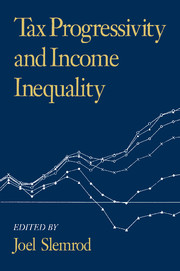Book contents
- Frontmatter
- Contents
- Preface
- List of contributors
- 1 Introduction
- 2 Trends in federal tax progressivity, 1980–93
- COMMENTS
- 3 The lifetime incidence of state and local taxes: measuring changes during the 1980s
- COMMENTS
- 4 Trends in income inequality: the impact of, and implications for, tax policy
- COMMENTS
- 5 The efficiency cost of increased progressivity
- COMMENTS
- 6 On the high-income Laffer curve
- COMMENTS
- 7 Tax progressivity and household portfolios: descriptive evidence from the Survey of Consumer Finances
- COMMENTS
- 8 Progressivity of capital gains taxation with optimal portfolio selection
- COMMENTS
- 9 Perceptions of fairness in the crucible of tax policy
- COMMENTS
- 10 Progressive taxation, equity, and tax design
- Index
7 - Tax progressivity and household portfolios: descriptive evidence from the Survey of Consumer Finances
Published online by Cambridge University Press: 20 May 2010
- Frontmatter
- Contents
- Preface
- List of contributors
- 1 Introduction
- 2 Trends in federal tax progressivity, 1980–93
- COMMENTS
- 3 The lifetime incidence of state and local taxes: measuring changes during the 1980s
- COMMENTS
- 4 Trends in income inequality: the impact of, and implications for, tax policy
- COMMENTS
- 5 The efficiency cost of increased progressivity
- COMMENTS
- 6 On the high-income Laffer curve
- COMMENTS
- 7 Tax progressivity and household portfolios: descriptive evidence from the Survey of Consumer Finances
- COMMENTS
- 8 Progressivity of capital gains taxation with optimal portfolio selection
- COMMENTS
- 9 Perceptions of fairness in the crucible of tax policy
- COMMENTS
- 10 Progressive taxation, equity, and tax design
- Index
Summary
If you drive a car, I'll tax the street
If you try to sit, I'll tax your seat
If it gets too cold, I'll tax the heat
If you take a walk, I'll tax your feet
George Harrison, “Taxman”Introduction
The 1980s were the “tax decade.” The 1981 Economic Recovery Tax Act lowered the top marginal individual income tax rate to 50% from 70%, lowered all marginal income tax rates by an average of 23% over a threeyear period, and implemented numerous tax preferences for individuals and corporations that were designed to stimulate saving and investment. Less sweeping changes to the income-tax code were made in 1982 and 1984. The Tax Reform Act of 1986 (TRA) again lowered rates substantially. The marginal tax rate on the highest-income households fell to 28% from 50%, while the top corporate rate was reduced to 34% from 46%. At the same time that marginal tax rates were reduced, both the individual and corporate tax bases were broadened. On the individual side, for example, TRA eliminated the deduction for state and local sales taxes, eliminated the exclusion for realized capital gains, and restricted eligibility for tax-deductible Individual Retirement Account contributions. For corporations, the investment tax credit was eliminated, the corporate alternative minimum tax was stiffened, and depreciation schedules were lengthened.
The striking reduction in statutory tax rates in the 1980s does not necessarily imply that the tax system became less progressive.
- Type
- Chapter
- Information
- Tax Progressivity and Income Inequality , pp. 219 - 267Publisher: Cambridge University PressPrint publication year: 1994
- 10
- Cited by

